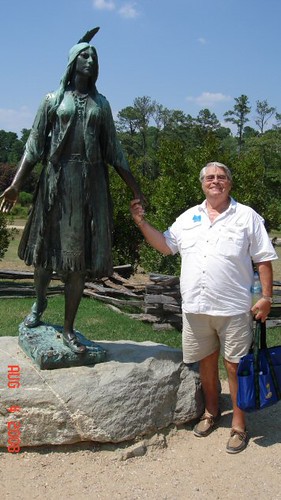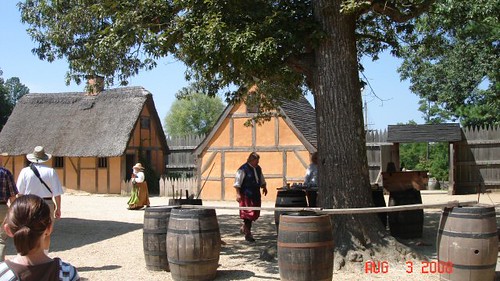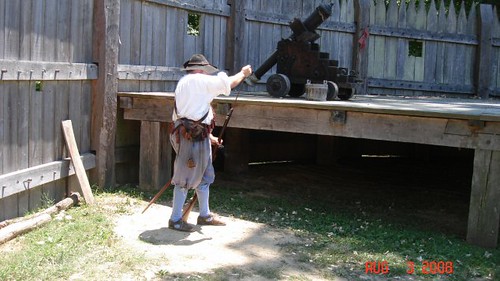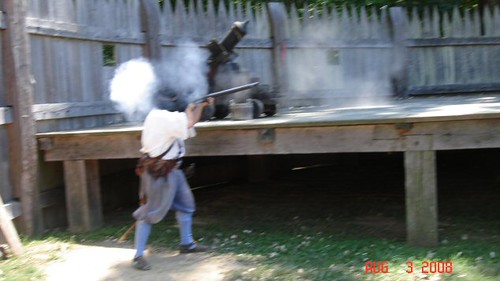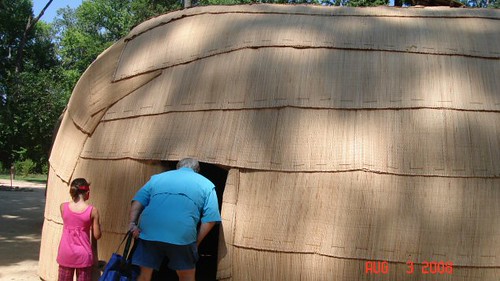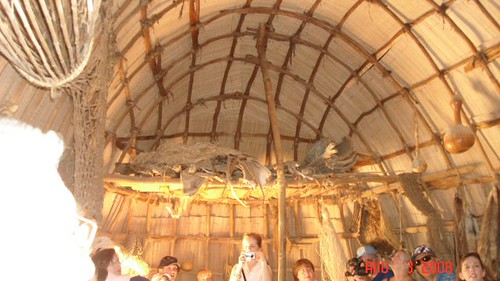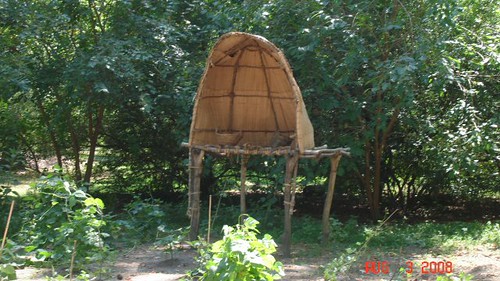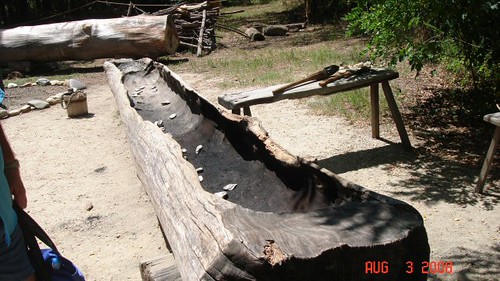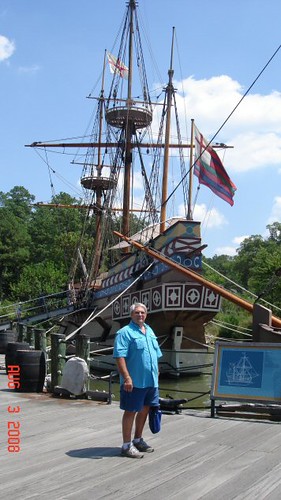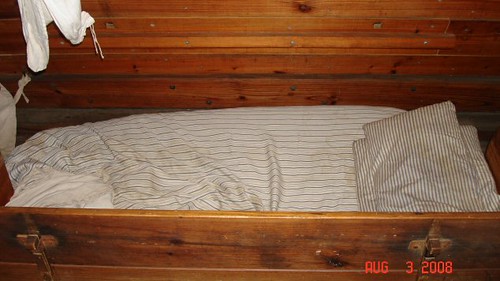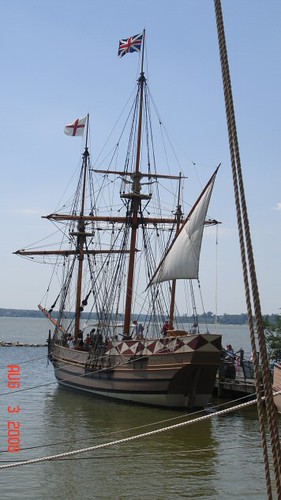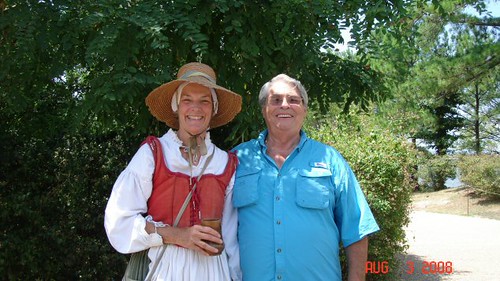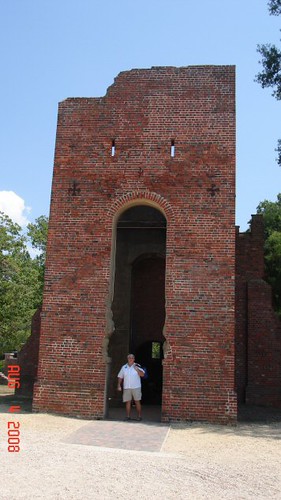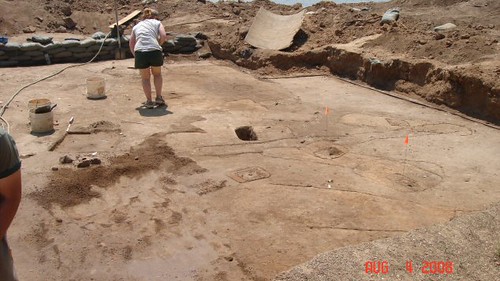We started our visit of this area in Williamsburg, but I thought it was more appropriate to start the blog of the “Historic Triangle†with our visit to Jamestown (James Towne), since this is where it all started.
Bear’s comment when we first started our visit of the area “I wish I had paid more attention in History class when I was youngâ€. Actually, this place makes learning history fun, it is not at all like reading about it in a book and trying to remember dates. Of course, the history I learned in class was a little different, it had to do with the French and the war we lost against the British in 1759, but here, we learn about American history, and it is fascinating.
A quick reminder: This is the site of the first permanent British settlement in America. (On the main land, because there was a British settlement in what is now Newfoundland, in 1589). There had been some attempts before in other places, but these settlers either were massacred by the Natives or they went back to England because the living conditions were too harsh.
So, in December 1607, 104 men and boys, colonists under a charter granted by James I to the Virginia Company of London, set sail for America, and 4 and a half months later (April 1608), they arrived at the mouth of what is today the James River and found a good spot to settle their camp. They established the colony of Virginia, with James Towne as its capital. Their goal of course, was to establish a profitable colony so the Virginia Company could make money.
The area was already successfully inhabited by over 14, 000 “naturalsâ€, the Powhatan Indians, who had lived there for generations. Their social organization was remarkable. You can imagine they were quite curious about these new settlers, the fact that they had no women with them, about their strange tools, and their way of doing things.
I won’t go into details, but times were hard, the colonists were starving, and although they were able to trade with the natives for food at the beginning, things were not always peaceful between the new neighbors, many died, but the colony did survive and would eventually thrive. The first women (2 of them, a woman married to a carpenter and her servant) would arrive in 1608. 90 unmarried women would arrive in 1620 in order to provide settlers with the opportunity to marry and start families. It took a while for the new colonists to find a way to be profitable, they tried many things, but they finally achieved their goal by growing Virginia tobacco which they exported to England.
Chief Wahunsenacawh (better known as Powhatan) ruled the area, and was the father of the famous Pocahontas, his favorite daughter, who saved the life of Captain John Smith twice during the first years of the colony. She also frequently visited the fort, bringing food and gifts from her father. In April 1613, Captain Argall kidnapped Pocahontas and brought her to Jamestown. While hostage, she received lessons in Christianity and converted, she was baptized. She later married John Rolfe, in April 1614; this marriage ensured peaceful relations between the Powhatans and the colonists. In 1616, she visited England with her husband Rolfe and their infant son Thomas, and was presented to the Royal Court. She died on March 21, 1617 in England and is buried in St. George’s Church in Gravesend, England.
Statue of Pocahontas
In 1619, privateers attacked a Portuguese ship and stole their cargo of African slaves, which they brought to James Towne. The status of these Africans in the colony is not exactly clear, there are records of black families owning land in the early days, what is certain though, is that by the mid 1700’s, laws had been passed and African Americans had lost all their rights and status, and were enslaved. 3 People, 3 different cultures, the British, the Powhatans and the Africans, their destiny and their interaction were to establish the foundation of what was to become the United States of America.
Jamestown was the capital of Virginia from 1607 until 1699, when the colony moved the government to Williamsburg.
What we can find in Jamestown today:
Today we can visit the Jamestown settlement, a replica of the fort where you can observe actors in costume living the way they would have been in the 1600’s.
You can observe a good demonstration on how to fire a musket! The picture on the right is blurry, because that was loud and even if I tried to be very still when it happened, the natural reaction to such a loud noise is to jump, which I did of course, but just a little bit 😉
You can also see a replica of a Powhatan Indian village.
This kind of structure, which has a name I can’t remember, housed one Powhatan family. The children were very important in the Powhatan culture; they started participating in sharing the chores of daily life as soon as they were able to imitate their parents (2 or 3 years old). They had specific chores to do, which were essential to the life of the community, like standing in a structure like this one and making a lot of noise, so the birds and animals would stay away from the garden (now I can just see my grandson Mathew doing that!) 😉
The Powhatans built canoes by bringing down a big tree in the water and then removing material from the inside of the trunk by burning and scraping. These canoes were very solid, floated well and were maintenance free for at least 50 years. The new settlers, who at first laughed at those canoes, soon learned their value and started to use them.
In this picture, the canoe is being made on land, but because of the sheer weight of these, originally they were made right on the water.
We can also climb aboard replicas of the 3 ships that brought the settlers to Jamestown.
You can just imagine how bad the conditions were on these ships, especially for such a long voyage. The flagship of the expedition was the Susan Constant;
With an overall length of 116’, and width (beam) of 24’10â€, it carried 54 passengers and 17 crew, that’s 71 people my friends, on a ship where the total living quarter space is not much bigger than the size of our motorhome, if you take into account that they had to carry enough supplies to be able to feed 71 people during almost 5 months, and on top of that, all the tools and odds and ends they would need to establish a colony. Huh, hmm No thanks! I’ll pass!
Bear in front of the replica of the Susan Constant and “luxurious†sleeping accommodations on board the ship… and a picture of the Discovery, a smaller ship. I am not kidding when I say luxurious, because most passengers didn’t even have a bed; they slept on top of cargo boxes, or on the floor, wherever they could find a spot.
We then went to Jamestown Island, the archeological site. For years, they thought that the emplacement of the original fort had been lost to erosion, until archeological digs found stains in the soil that indicated wood had stood and rotted there, they had found the fort! It was originally about 200 yard from the water, but it is now very close to it, so they built a sea wall to stop the erosion around the island.
As usual, bear made a new girlfriend:
after his conversation with his new flame, we walked down to the original fort, where we can find today, the still-standing tower of a church built in 1686, using the foundations of the earlier church who had burned.
Abandoned in 1750, the church fell in ruins by the 1790’s, and although the tower remained intact, bricks for the other portion of the church were used to build the present graveyard wall. The first church on this site was built in 1617, and it is in that church that the first legislative assembly in America convened from July 30 to August 4, 1619.
It is interesting to observe the work of the archeologists who are digging on site, they are willing to stop and talk to you as you walk by.
They found many artifacts from the period who are now housed in the Archaearium museum not far from the fort. No pictures were allowed in the museum.
